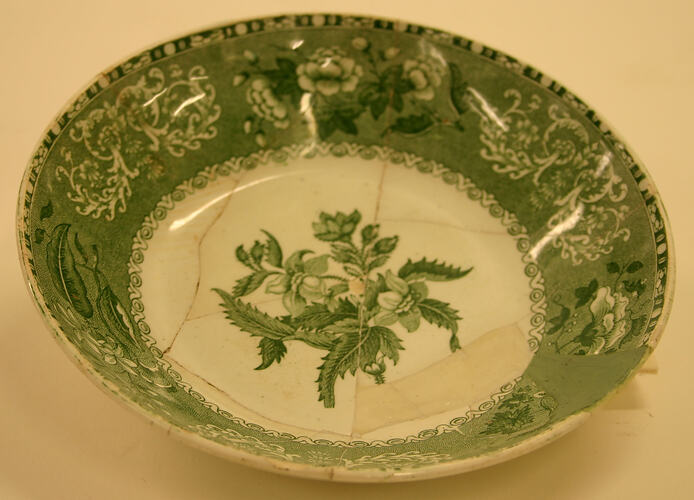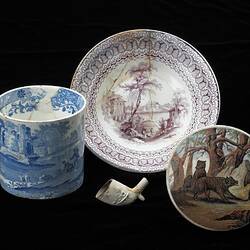Summary
This saucer was reconstructed from 12 fragments that were excavated at one of the digs on the Commonwealth Block between 1988 and 2003. It is decorated with a pattern known as 'Camilla'.
Homewares.
Numerous crockery pieces were found all over the Little Lon site. Crockery gives us a glimpse of everyday life in Melbourne in the 1880s. In the houses around Little Lon, residents used decorated crockery. Most pieces were cheap earthenware or stoneware, yet provided colour and cheer. Only a few could afford to buy matching sets, and most china was probably acquired second-hand. Some were once expensive pieces. Householders mixed and matched their crockery from the great range of mass-produced designs available. 'Blue and white' and the 'willow' pattern, was the most popular choice and was produced by English potteries from 1790.
Physical Description
This is a saucer which has been reconstructed form 12 fragments, the pieces that are missing have been filled in. There is a green on white underglaze transfer printed floral/abstract design on the rim and base. The saucer has curved rim with no well.
Physical Description
12 fragments of ceramic saucer adhered together. Green on white underglaze transfer printed floral/ abstract design on rim and base. Manufacturers mark underneath base reads 'Copeland Late Spode', with production number '11'. Saucer has curved rim with no well. Pattern: 'Camilla'. Restored by Conservation for Myer China and Glass Exhibition, April 1998. See photocopied material in Supp.File 04/55/-/35/-
More Information
-
Collection Names
-
Collecting Areas
-
Acquisition Information
Transfer from Heritage Victoria, Industry Superannuation Property Trust, 03 May 2005
-
Manufacture Name
-
Manufacture Date
-
Manufacturer
W T Copeland, Stoke-on-Trent, Staffordshire, England, Great Britain, 1847-1867
-
Inscriptions
On base: 'COPELAND LATE SPODE' with production number '11' (TP).
-
Context Number
57/13
-
Site
[TCS] Australia, Victoria, Commonwealth Block, Melbourne
-
Distinguishing Marks
Manufacturers mark underneath base reads 'Copeland Late Spode' with production number '11'
-
Activity
-
Specific Activity
-
Decoration
-
Colour
Green
-
Moulding
Camilla
-
Form
Curved Marly Rim; Cylindrical Foot (Base)
-
Shape
Round
-
Technique
-
Provenance
England, Staffordshire
-
Classification
-
Category
-
Discipline
-
Type of item
-
Exhibition Collection Management
157 mm (Width), 34 mm (Height)
-
Dimensions
3.5 cm (Height), 16 cm (Outside Diameter)
Measurement From Conservation. Measuring Method: Maximum
-
Keywords


